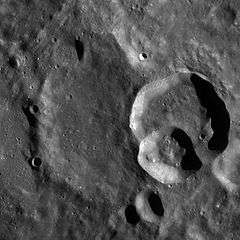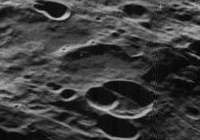Stetson (crater)
Stetson is the remains of a crater on the far side of the Moon. The northeastern part of the rim of Stetson has been overlain by the larger crater Blackett. Lying across the eastern rim is a double-crater formation consisting of the satellites Stetson E and Stetson G. There are also small craters along the southeast and northwestern rims.
 LRO WAC image of Stetson at left, with Stetson E and G at right | |
| Coordinates | 39.6°S 118.3°W |
|---|---|
| Diameter | 64 km |
| Depth | Unknown |
| Colongitude | 120° at sunrise |
| Eponym | Harlan T. Stetson |


Only the portion of the rim that is still relatively intact is from the west-northwest counter-clockwise to the south. The surviving rim and the remaining interior floor are relatively indistinct, possibly due to deposits of ejecta from the Mare Orientale impact basin to the northeast. Radial streaks of ejecta and secondary craters cover the terrain that surrounds Stetson and Blackett.
Satellite craters
By convention these features are identified on lunar maps by placing the letter on the side of the crater midpoint that is closest to Stetson.
| Stetson | Latitude | Longitude | Diameter |
|---|---|---|---|
| E | 39.4° S | 117.0° W | 38 km |
| G | 39.9° S | 117.2° W | 23 km |
| N | 43.2° S | 120.2° W | 18 km |
| P | 41.8° S | 119.8° W | 24 km |
References
- Andersson, L. E.; Whitaker, E. A. (1982). NASA Catalogue of Lunar Nomenclature. NASA RP-1097.CS1 maint: ref=harv (link)
- Blue, Jennifer (July 25, 2007). "Gazetteer of Planetary Nomenclature". USGS. Retrieved 2007-08-05.CS1 maint: ref=harv (link)
- Bussey, B.; Spudis, P. (2004). The Clementine Atlas of the Moon. New York: Cambridge University Press. ISBN 978-0-521-81528-4.CS1 maint: ref=harv (link)
- Cocks, Elijah E.; Cocks, Josiah C. (1995). Who's Who on the Moon: A Biographical Dictionary of Lunar Nomenclature. Tudor Publishers. ISBN 978-0-936389-27-1.CS1 maint: ref=harv (link)
- McDowell, Jonathan (July 15, 2007). "Lunar Nomenclature". Jonathan's Space Report. Retrieved 2007-10-24.CS1 maint: ref=harv (link)
- Menzel, D. H.; Minnaert, M.; Levin, B.; Dollfus, A.; Bell, B. (1971). "Report on Lunar Nomenclature by the Working Group of Commission 17 of the IAU". Space Science Reviews. 12 (2): 136–186. Bibcode:1971SSRv...12..136M. doi:10.1007/BF00171763.CS1 maint: ref=harv (link)
- Moore, Patrick (2001). On the Moon. Sterling Publishing Co. ISBN 978-0-304-35469-6.CS1 maint: ref=harv (link)
- Price, Fred W. (1988). The Moon Observer's Handbook. Cambridge University Press. ISBN 978-0-521-33500-3.CS1 maint: ref=harv (link)
- Rükl, Antonín (1990). Atlas of the Moon. Kalmbach Books. ISBN 978-0-913135-17-4.CS1 maint: ref=harv (link)
- Webb, Rev. T. W. (1962). Celestial Objects for Common Telescopes (6th revised ed.). Dover. ISBN 978-0-486-20917-3.CS1 maint: ref=harv (link)
- Whitaker, Ewen A. (1999). Mapping and Naming the Moon. Cambridge University Press. ISBN 978-0-521-62248-6.CS1 maint: ref=harv (link)
- Wlasuk, Peter T. (2000). Observing the Moon. Springer. ISBN 978-1-85233-193-1.CS1 maint: ref=harv (link)